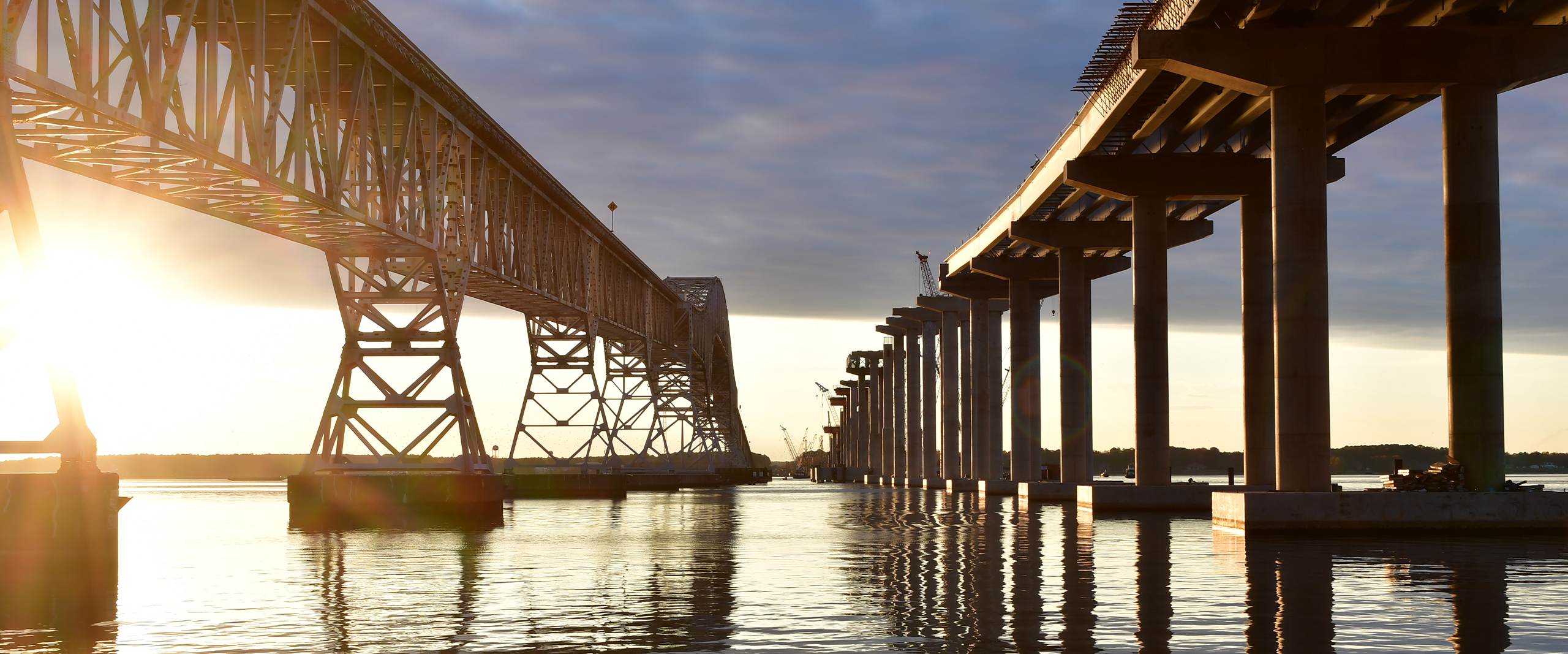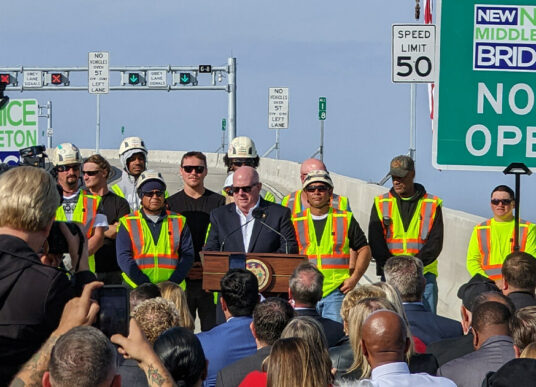With a high volume of commuters traveling to and from Washington, D.C., it is imperative that major roadways allow for traffic to flow smoothly throughout the surrounding metropolitan area.
The Governor Harry W. Nice Memorial/Senator Thomas “Mac” Middleton Bridge, originally built in 1938, was a narrow 1.9-mile bridge that carried U.S. Route 301 across the Potomac River and connected the states of Maryland and Virginia. As traffic needs continuously increased throughout the years, the Maryland Transportation Authority (MDTA) proposed a plan in 2006 to either widen or replace the bridge with a structure that would feature shoulders and handle a higher capacity of vehicles. Planning and design continued for 14 years to address interdepartmental needs for the vital roadway and, once the decision was made to build an entirely new bridge adjacent to the current crossing, construction for the design-build project finally began in 2020, led by the Skanska, Corman, and McLean tri-venture team.
The new structure was slated to replace the existing two-lane bridge with a four-lane crossing designed to support more than 18,000 vehicles on average each day for the next 100 years. Serving in a joint venture capacity, KCI provided construction management and inspection (CMI) services that included lead structural inspections, facility construction management, material testing, maintenance of traffic (MOT), environmental compliance monitoring, document control, and overseeing intelligent transportation system (ITS) installation for the proposed structure and the addition of six new administrative facilities adjacent to the new bridge structure on the Maryland shore.
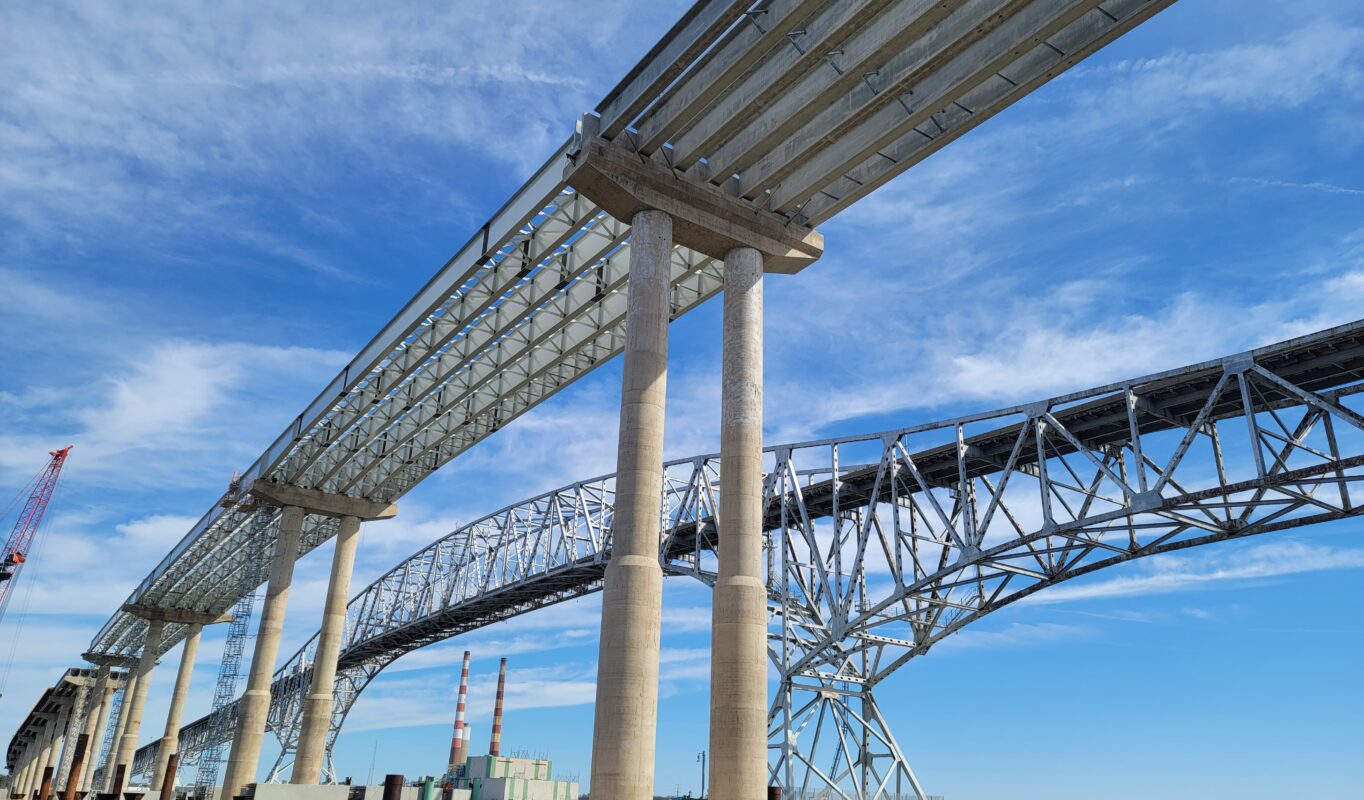 In order to address the increasing number of drivers in the Maryland/Virginia area, constructing an entirely new bridge was a more feasible solution than renovating the existing structure.
In order to address the increasing number of drivers in the Maryland/Virginia area, constructing an entirely new bridge was a more feasible solution than renovating the existing structure.In July 2020, the first phase of bridge construction began with piles in excess of 200 feet driven into the river bottom to support the new structure. While substructure elements were being placed, KCI monitored the transition of materials from a concrete batch plant on the riverside to floating barges that conveyed concrete onto columns in the Potomac River. Typically, concrete placement is a relatively routine and streamlined process, but to accommodate the layers of coordination needed to move the batches to their final locations, additives were introduced to extend the mixture’s working time prior to setting. This led to unpredictable changes in the mix and required careful monitoring to ensure that the concrete did not set prematurely. Our inspectors provided feedback to contractors through test results and offered novel approaches for performing timely inspections on concrete pours to address the atypical nature of the procedure.
Three types of piles were driven into the ground across the Potomac to a specific depth depending on the soil strata type. On either side of the navigation channel, the piles were hollowed and filled with concrete, displacing stagnant water from inside the foundation in the process. To combat the environmental concerns of the now-turbid water spilling into the river, the contractor utilized portable water treatment systems, known as grooms, and was granted an industrial discharge permit to proceed. Each day during the entire concrete placement process, 5,000 gallons of 14-pH water was pumped through the grooms to reach an acceptable pH balance of 7 in order to continue operations without interruption. Inspectors then oversaw daily concrete placements into the precast tubs, thus sealing the forms that were placed around the piles.
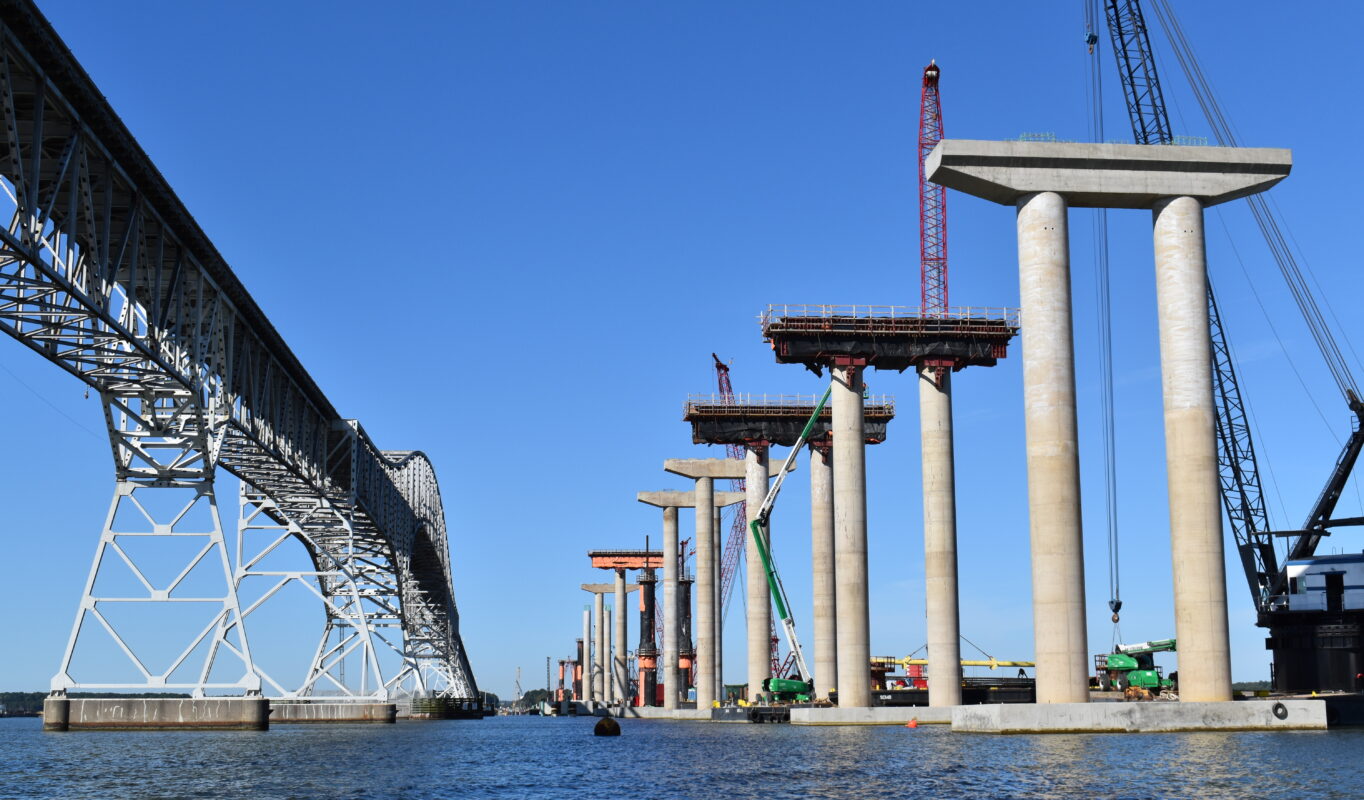 As vertical piles were driven into the river bottom, adjacent concrete piers were cast and installed to prepare for girder and bridge deck placement.
As vertical piles were driven into the river bottom, adjacent concrete piers were cast and installed to prepare for girder and bridge deck placement.KCI also served as a liaison from the field to state and federal environmental agencies and built an environmental compliance system from the ground up to ensure the project stayed in compliance with all environmental permits. KCI utilized Survey123 to create a tracking database to coordinate environmental compliance data across all environmental documentation and utilized PlanGrid for expedited plan review and to keep the project staff updated on any changes to the design.
In addition to maintaining the project’s environmental database, KCI led all project document controls, coordination, and training of Office Engineer staff for the project. Our team launched an electronic reporting system for concrete inspection tool to streamline and capture material tickets electronically and managed the platform internally for project staff and auditors. Additionally, KCI managed the electronic Maryland Construction Management System (eMCMS) used to produce Contractor pay estimates throughout the project duration.
Roadway MOT was set in place to control traffic and access to the construction site, monitored daily by KCI until the final switch from the old bridge to the new to ensure commuters were able to travel safely through the work zones while construction continued. As traffic signing and the new electronic toll gantries were installed, KCI provided training for the updated ITS equipment to all construction inspection personnel from our lead ITS engineer. Furthermore, additional tasks such as overseeing directional boring, soil and concrete testing, providing quality assurance for bridge deck formwork and placements, conducting roadway pavement inspections, coordinating utility relocations, and performing highway realignment were completed with minimal interruption to the traveling public.
“The entire KCI team played a vital and versatile role on this mega construction project. Without a coordinated effort by the project team that kept everyone onsite safe, operational, and up to date on progress, this bridge wouldn’t have been built as quickly and successfully as it was.”
Adam Gardner, CCM, SCTPP, Practice Leader
While the new crossing was being built, administrative toll facilities within the bridge footprint were simultaneously constructed to replace outdated existing structures. A maintenance building, dewatering station, equipment storage unit, automobile shop addition, fuel storage and dispensing system, and a police/administration facility were added to KCI’s scope. As work was completed for the structures, KCI conducted CPM schedule reviews, budget oversight, change order processing, claim handling, QA/QC, and system commissioning for the buildings’ construction. A variety of trees and bushes were planted while swales, new drainage, and bioretention ponds were installed to support the site and keep water runoff from flowing directly into the Potomac River.
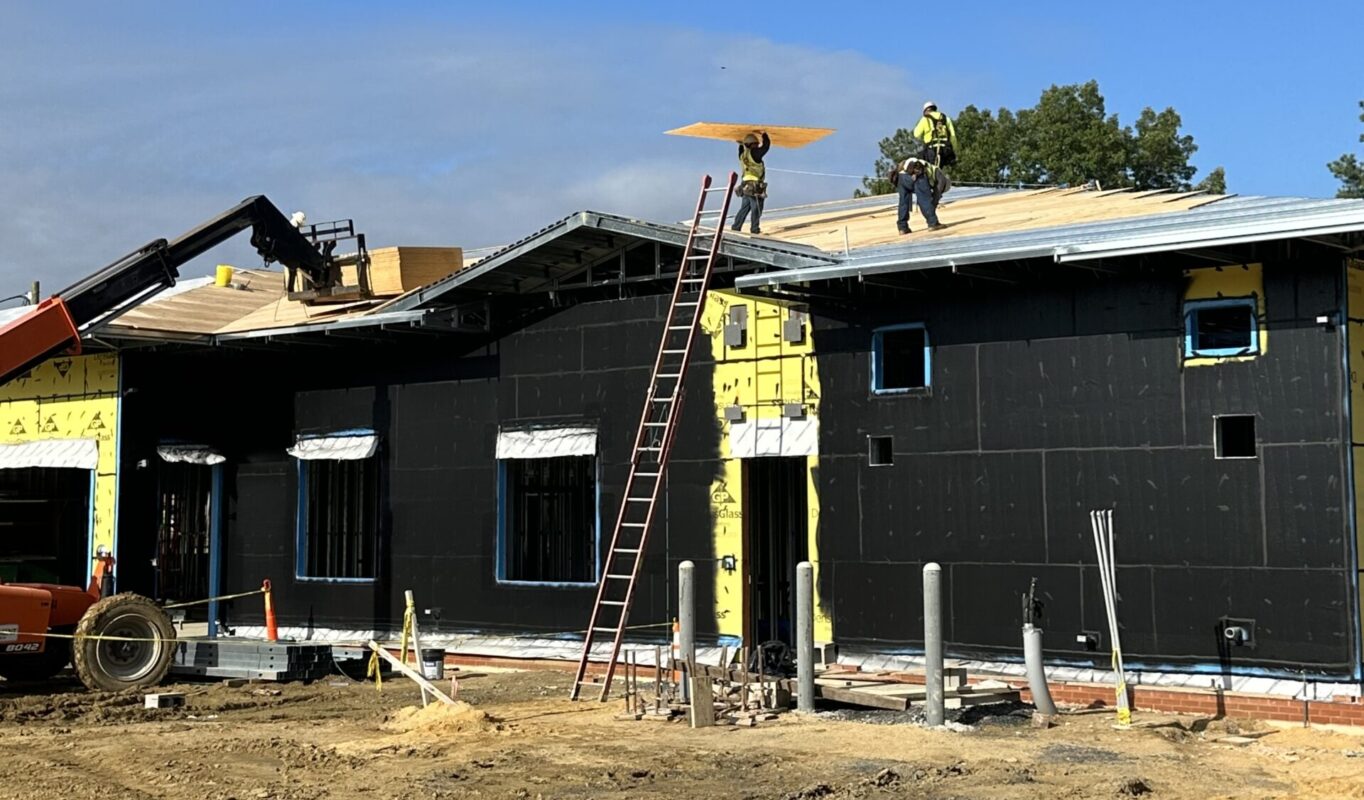 The new administrative campus is positioned adjacent to the bridge, enabling maintenance personnel to be readily available if needed.
The new administrative campus is positioned adjacent to the bridge, enabling maintenance personnel to be readily available if needed.To accomplish both projects at the same time, it was imperative to keep an open line of communication between the bridge and facility teams. Comprehensive coordination was key to project completion without interfering with the proposed schedules. As COVID-19 was actively changing the way construction sites were handled across the world, our staff kept everyone involved up to date on the overall status through several virtual means, such as video streaming, online meetings, and electronic documentation platforms. Securing adequate staffing was also a concern as the project is in a remote location and was accomplished by providing training and mentoring to lesser-experienced workers that lived nearby, eventually leading to the creation of more than 500 jobs in Southern Maryland. In addition, effective MOT measures that guided drivers across the existing bridge structure allowed work to continue at all hours without a single shutdown.
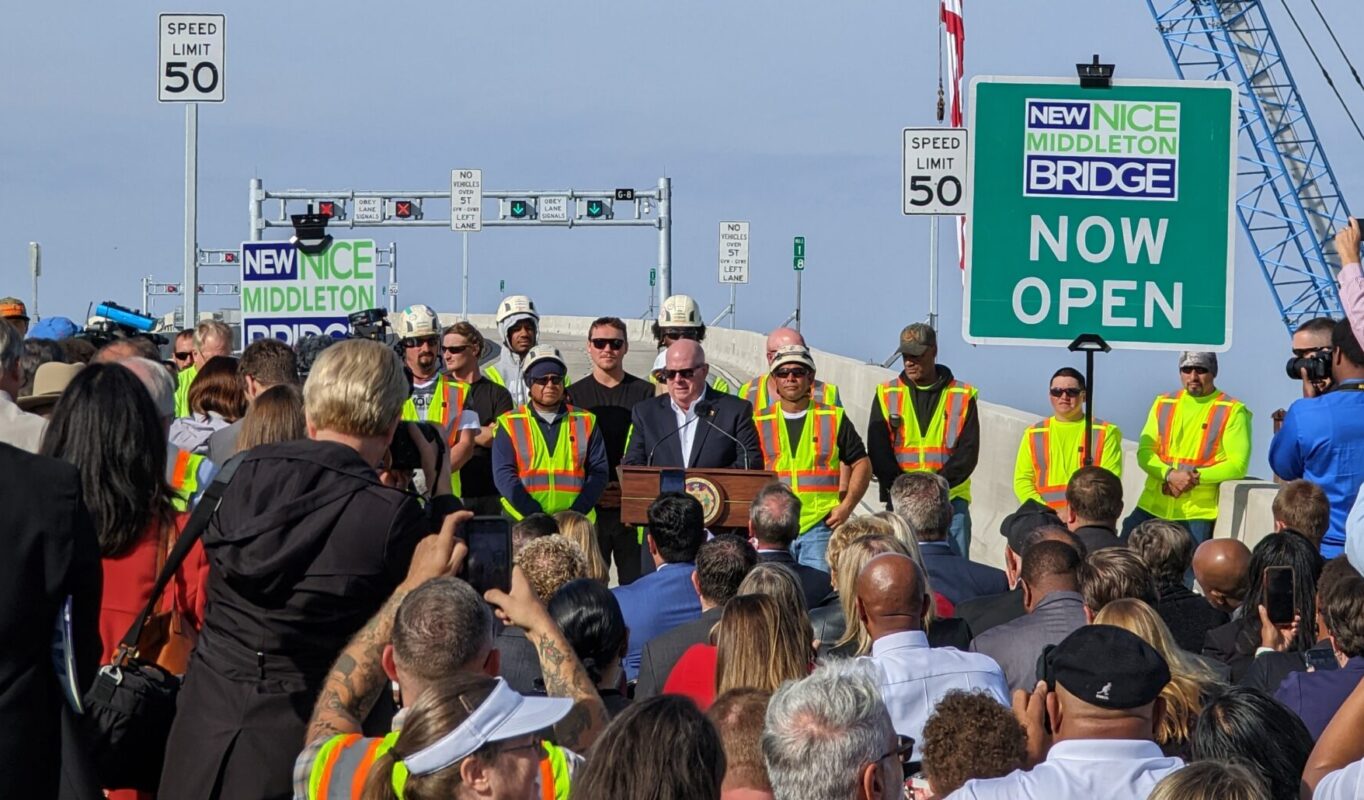 The accelerated construction led to the new bridge opening three months ahead of schedule.
The accelerated construction led to the new bridge opening three months ahead of schedule.Working under a tight time frame, the team completed construction and the new $462 million Nice/Middleton bridge was successfully opened with only two years from the first indicator piles being placed in the water to the ribbon-cutting event. The previous 82-year-old structure is being demolished, with portions used to construct an artificial reef to support marine life in the area. With twice the capacity for vehicular traffic and increased safety features such as larger lane widths, multiple lanes in each direction, and shoulders on each side, the new crossing will carry more travelers safely and expeditiously across the Potomac for decades to come.
